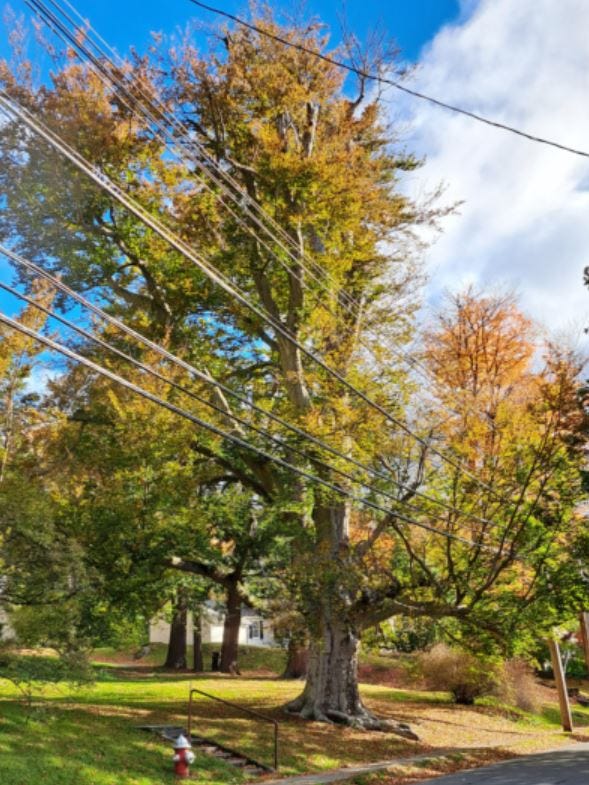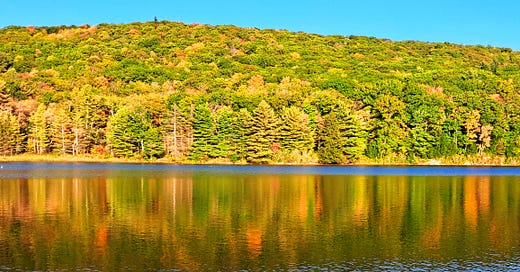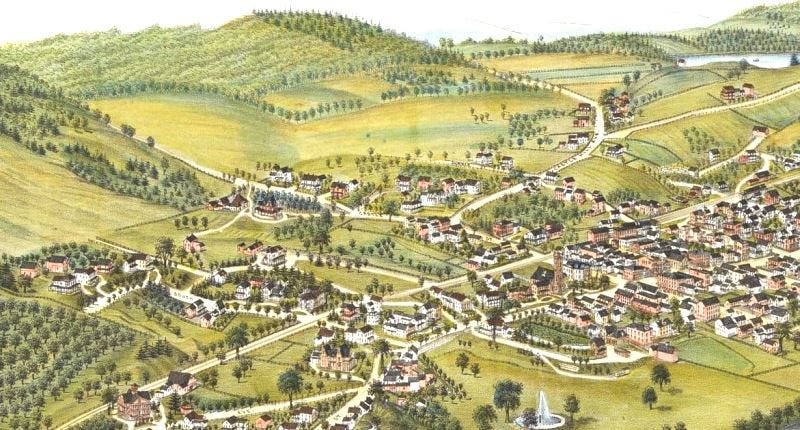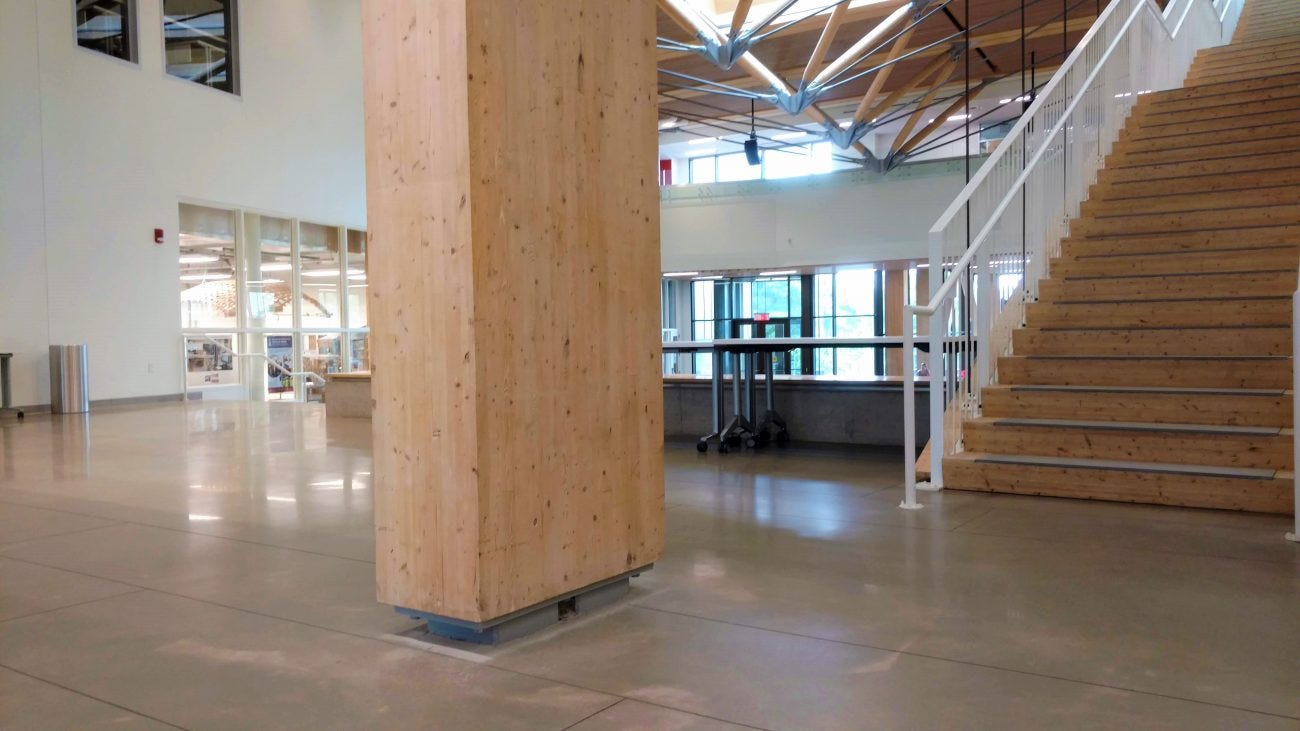It’s autumn in New England and the peepers are here. Not the spring peepers, tiny tree frogs whose sound echoes across the wetlands as soon as the ice begins to melt, but the leaf-peepers, the tourists who flock to see the hillsides ablaze.
The colors unfold from week to week. The maples blaze first (at their best, they are fiery red). The finale - still a week or two away - is when the oaks are at full color: blood red, tawny bronze, and gold. We’re in the middle now, the hills are bright, and weather prediction for the coming weekend is perfect. (The October holiday weekend - Indigenous Peoples/Columbus) Day - was a little too early and it rained day Sunday and Monday.)
New England is probably the only part of the planet to be reforested in the last one hundred years.
Early landscape paintings and maps show bare hillsides, but the farmers moved west and the forests came back. This is scenic, of course, but it’s also a big part of what makes this region so attractive as a place to live year-round (if only there were jobs, and more people!).
One reason the tourists love Great Barrington is that they can see the hills while they’re shopping in the boutiques along Main Street - that’s a weekend in the country to some people. You can see photos take a few blocks from where I live, and where Berkshire Publishing is based, in last week’s article in the New York Times about what to do if you have only (gift link) “36 Hours in the Berkshires.”
You know how important trees are in terms of climate change, but there’ve been a few news items of late that make it clear that trees, worldwide, are also hugely valuable as an alternative to other building materials and important to human health and well-being. Here are a few items I hope you’ll find inspiring.
Wood vaulting discovery
There are lots of supposed “discoveries” that are really old news or so obvious you want to knock your head against the wall. But this is actually news, and good news.
Understanding the unique environmental factors that kept that ancient log in mint condition could help researchers perfect an emerging climate solution known as “wood vaulting,” which involves taking wood that is not commercially viable—such as trees destroyed by disease or wildfires, old furniture or unused construction materials—and burying it to stop its decomposition.
Read the whole thing: Discovery of 3,775-Year-Old Preserved Log Supports ‘Wood Vaulting’ as a Climate Solution | College of Computer, Mathematical, and Natural Sciences | University of Maryland
Building with wood
One of the big misconceptions of the green movement is that we should never cut down trees. You’ve seen those email signatures, haven’t you? “Save trees, be green, don’t print this email.” As if storing thousands and millions of emails online has no environmental cost! There are a myriad of uses for wood, some of them destructive and wasteful and others sound and ecological.
One of the best uses of timber is construction. The John Olver Design Building at UMass, Amherst is the “largest and most technologically advanced academic contemporary wood structure in the US.”
I read the card on the wood column in the photo above while waiting for the group to gather for dinner after my lecture at UMass last month. Here’s the text:
This column is not a steel column wrapped in wood!
It’s actually a solid, glue-laminated timber made from Canadian Black Spruce that measures 14-1/4” x 31-1/2”. It supports a quarter of the roof garden (including its structure, soil, plants, people and snow) plus loads from the stairs, upper floors, and roof and is designed to carry a total of 425 kips (that’s 425,000 pounds).
As it turns out, wood is easily able to carry high loads “along its grain” (parallel to the fibers) – after all, that is the orientation how wood cells grew within a tree. Therefore, even a very large building load like the one we have here is not a problem at all for this material.
Given this structural importance, don’t we need to fire-protect this column? As it turns out, massive wood is inherently fire-protected by its large dimension. While it would char in a fire, its cross-section reduces very slowly when it burns (imagine putting a large log on a campfire) and it will support load often for a longer time than other materials. That’s why this column doesn’t need the added expense of fire-protection and drywall.
This column is naturally beautiful, sustainable, strong, and safe!
Knowing that made me feel more comfortable about the trees holding up my 1868 house! They are relatively small supports, along with brick and stone, but there are a lot of them and I’m glad to know just how strong they are. I admit that I have added some metal jack posts in a few places.
Read more, including information about the Canadian company that is a leader in wood building technology.
Home Ecology Notes
Another good use of wood is cutting boards. When I first wrote about green living there was a lot in the news about salmonella and there was debate whether wooden cutting boards were hygienic. It turned out that wood has antibacterial properties, as well as being a renewable resource. But ever since this I’ve used a variety of cutting boards: one for meat, another for garlic and onions, and so on. It’s a little surprising to see how that collection has grown! I especially love the vintage round BREAD board, and a big bamboo cutting board that my son brought from China. Read more How to Clean and Care for Wood Cutting Boards | Reviews by Wirecutter.
Poems are made by fools like me,
But only God can make a tree.
Trees in other forms
Were you like me, thinking that cork wine bottles would disappear entirely, to be replaced by plastic? Not so. Cork is renewable, and proves to be an enduring harvest: How ancient cork forests could help solve the world’s plastic problem - The Washington Post.
There are times when trees need to come down. In London, one had to have planning permission even to remove a weed tree that had grown so large it was knocking bricks out of the garden wall between our flat and next door. I benefited this week when the town took down a scrappy maple, opening the view from my office windows to East Mountain. I left the equally scrappy US infrastructure in the photo, in the interest of journalistic integrity - but the view is otherwise quite lovely. 1
Further down the street is a copper beech. I love this tree but it’s clearly not in great shape. The main upper branches seem to be dying. Its side trunks look healthy, but you can see that it’s not in a great position today, with the sidewalks and overhead wires and surrounding trees. I love the way it perseveres in beauty and grace. Take a look at the trees around you. It’s no wonder that some cultures worshipped trees, and endowed them with spirits!2


And what would third places be without trees? They make street corners and steps comfortable, and help with the sense of transition that you can see in the terrace photo that accompanies our podcast Kathy Giuffre about her village pub in Italy. The drawing belong comes from the original The Great Good Place and it’s a mystery: Ray Oldenburg couldn’t remember where it came from, but it seems integral to his story so I continue to use it.
This story is about a similar tree, that was put to new uses: “A beloved sugar maple slowly succumbed to disease. Today, it lives on in a new form.”
One of my delights as a publisher is when an eminent author agrees to write a short essay for one of Berkshire’s publications. I remember the thrill when the historian Arthur Rackham contributed a piece about trees in world history. It includes a section about the cultural and spiritual value of trees. You can download the PDF here.













Karen, I've had an instagram account for several years https://www.instagram.com/beechtreegraffiti?utm_source=ig_web_button_share_sheet&igsh=ZDNlZDc0MzIxNw== It turns out Beech trees are one of the few trees that attract people to carve their names on often in Lovers Lanes. I'm thinking seriously about the Lovers lane idea and maybe trying to get a book done about it, as it also turns out that Beech trees attract the love struck! Let me know if you've found anything similar on walks in woods around you and if so maybe collaborate on a book?
Thank you for this lovely story, and all the insights and references. And I love seeing the photo from Beartown State Forest. I just camped there for the first time last week, what a gorgeous place. And great for tent campers.